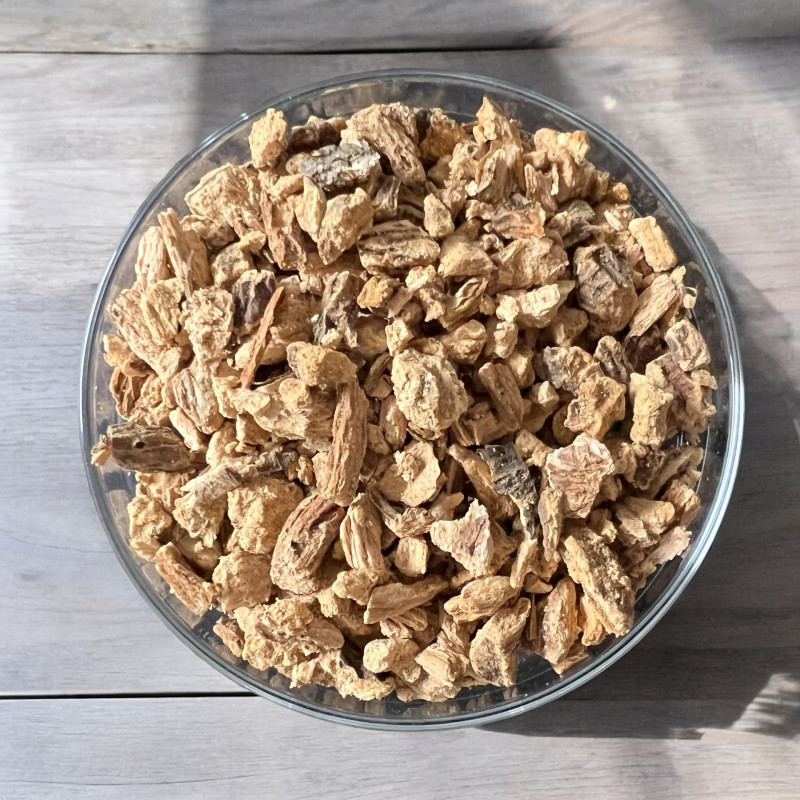- Reduced price



Its bitterness is pronounced, which is exactly why it's so sought after!
With it, you can prepare spirits, aperitifs, and invigorating herbal teas, as it is full of beneficial properties.
 Delivery
Delivery
Mondial Relay
 Returns
Returns
See conditions
 Payments
Payments
100% secure
Livré en sachet refermable
- ORIGINE FRANCE -
°°°
Appearance:
Offered in 2 versions: whole or cut roots
Whole roots: their length and diameter vary greatly, ranging from a few centimeters to about twenty centimeters in length and from 1 to 5 centimeters in diameter. Their weight also varies, from around ten grams to nearly 70 grams for the largest roots. Since they are not very hard, you can easily cut them to suit your needs.
Cut roots: cuts vary from a few millimeters to about 2 centimeters.
Uses in Cooking and Beyond:
It is the roots of the plant that are used, either macerated or distilled, for making liqueurs and aperitifs like Suze, Avèze, Salers, and Picon. The flavor these roots provide is intensely bitter, which is precisely what is sought in these drinks. The roots are also distilled to produce a powerful-flavored brandy.
Additionally, they are used in infusions for their many medicinal benefits.
Who am I?
Origin: France
Scientific name: Gentiana lutea
Common names: Yellow gentian, great gentian, officinal gentian, European quinine
The name "gentian" encompasses several varieties of plants, some of which have trumpet-shaped flowers in an extraordinary blue. Nearly all are protected in the wild, where picking or uprooting them is prohibited.
The yellow gentian of interest here is a tall, robust, perennial plant from the Gentianaceae family, growing up to 1.50 meters, and abundant in several European mountain ranges, including the Alps, Pyrenees, Vosges, Massif Central, and Jura. It can live up to 50 years and takes 10 years to flower for the first time! The roots can reach 1.50 meters in length and weigh 5 to 7 kg. Large yellow flowers cluster at the base of the upper leaves and bloom from June to August. The leaves are opposite and veined, which helps to distinguish it from another plant it can be mistaken for, "white hellebore," a deadly poison whose leaves are alternate. The plant prefers open spaces, mountain grasslands, and acidic soils. Livestock do not consume it.
Harvesting, which is strictly regulated, mainly takes place in the Massif Central by the Gençanaïres, who can extract over 200 kg of roots per day from May to July. After drying, distillation occurs during the winter. It takes 15 kg of roots to produce 1 liter of gentian alcohol, traditionally consumed as a digestive. Between 1,000 to 1,500 tons are used annually in the industry.
In terms of volume, it is one of the top three medicinal and aromatic plants used in France.
A Little History:
The history of gentian dates back to at least Ancient Greece, when it was already used for its appetizing, digestive, and tonic properties. In the Middle Ages, it was an ingredient in miracle remedies. In the 18th century, it was said that regular consumption ensured health and longevity.
Data sheet
 Michelle C.
Michelle C.
nouveau conditionnement très bien

 Michelle C.
Michelle C.
nouveau conditionnement très bien

Reference: camomilleRom
Reference: 20731803
Reference: badianeE
Reference: 6N7456401
Reference: vinchaud
Reference: 20731803
Reference: 3N7137901
Reference: 2071570
Reference: punch
Reference: EPI2301010
Reference: vermouth
Reference: baieroseE
Reference: 2M6273801
Reference: ecorcecitronH
Reference: ecorceorangeamere
Reference: hypocras
Reference: 10N7738802
Reference: 9N7669901

Its bitterness is pronounced, which is exactly why it's so sought after!
With it, you can prepare spirits, aperitifs, and invigorating herbal teas, as it is full of beneficial properties.